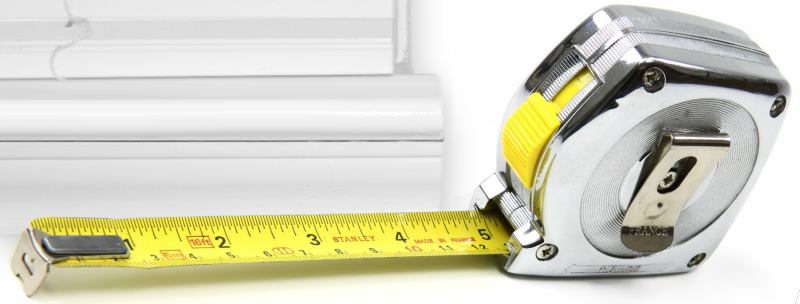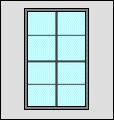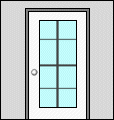How To Measure for Custom Blinds & Shades
Measuring windows for blinds and shades is not a daunting task. Please observe the following instructions to ensure a beautiful fit for your new blinds. If you have any concerns or questions please do not hesitate to call our customer service department at 888-650-6873.
The guide below is designed to provide important information before placing an order. If you still have questions regarding how to measure for your blinds or the guide below does not address an unusual application, please contact us before ordering.
Customer Service
Phone: 888-650-6873
OFFICE HOURS:
Monday - Friday: 8:00am - 6:30pm CST
Saturday: email support only
Child Safety Info
Window Covering Safety Council
Learn how you can reduce the risks in your home when it comes to installing window blinds.
Phone: 212-297-2100
Email: info@windowcoverings.org
Before You Measure

- The first thing to remember is never use a cloth tape to measure. Always use a steel tape measure of adequate length to fully measure the width and length (height) of each window. For instance, do not try to use a 36" tape for windows that are wider or taller than 36". Always measure the window encasement - do not measure an existing window shade or blind.
- Secondly, always measure every window even if you think the windows are the same size. No two windows in your home are the exact same size. Our blinds and shades are custom crafted to fit each window and therefore each window must be measured individually.
- Basically, there are 3 categories of windows: INSIDE MOUNT, OUTSIDE MOUNT and DOOR MOUNT. When ordering from us, we require the type of mount to be specified because it determines how the manufacturer sizes the blinds. Make sure to make this distinction when measuring a custom window covering.
Inside Mount
 INSIDE MOUNT refers to a blind or shade that will be installed inside a window frame/encasement. That is, the window is recessed and the blind or shade will hang inside the window frame/encasement. To install inside mounted blinds or shades, for 2" blinds the window must be recessed at least 2" inside the window encasement. For 1" blinds and cellular and pleated shades the window must be recessed at least 1/2" inside the window encasement. Please note: If your windows are in a wall that is curved rather than straight please call us before placing your order - 888-650-6873.
INSIDE MOUNT refers to a blind or shade that will be installed inside a window frame/encasement. That is, the window is recessed and the blind or shade will hang inside the window frame/encasement. To install inside mounted blinds or shades, for 2" blinds the window must be recessed at least 2" inside the window encasement. For 1" blinds and cellular and pleated shades the window must be recessed at least 1/2" inside the window encasement. Please note: If your windows are in a wall that is curved rather than straight please call us before placing your order - 888-650-6873.
Measure the width of each window opening or encasement in 3 locations - top, center and bottom. Use the smallest of the 3 measurements and if your measurement falls on a sixteenth of an inch narrow it to the nearest 1/8". Example: your window encasement at the top is 36 3/16" wide. At the center of the window encasement the width is 36 5/16" and at the bottom of the window encasement the width is 36 3/8". Since you use the smallest of the 3 measurements you would use 36 3/16" then narrow it down to the nearest 1/8". So in this case you would order your blind or shade 36 1/8" wide. Do not make any other deductions or allowances. The factory will make the necessary reductions, according to industry standards, in order for the blind or shade to fit your window properly.
Then measure the height or length of the window encasement from the top to the bottom in 3 locations: from top to bottom on each side and also in the center of the window encasement. Use the longest measurement rounded up to the next 1/8". Example: The left side of the window encasement, from top to bottom, is 71 5/16". The right side of the window encasement, from top to bottom, is 71 3/16 and the center of the window encasement, from top to bottom, is 71 1/2. Since you will use the longest of the length measurements, in this case, you will use 71 1/2" and round up to the nearest 1/8". So the length measurement for this order is 71 5/8.
TILE CUT-OUT: If your windows have granite or tile splash guards inside the actual window encasement the blinds should be cut to accommodate free movement and operation. We've simplified entering this information. If your blinds require a tile cut-out, select the tile cut-out option from the product page. An easy-to-follow form will display on the next page for the measurements. Please call our toll free number if you have questions. Note: cut-outs are an additional charge.
Outside Mount
 OUTSIDE MOUNT refers to blinds or shades that hang outside the window frame and overlap the window frame. Typically, you would want an outside mounted blind or shade for windows that are not recessed or for windows that have a very shallow encasement and for doors.
OUTSIDE MOUNT refers to blinds or shades that hang outside the window frame and overlap the window frame. Typically, you would want an outside mounted blind or shade for windows that are not recessed or for windows that have a very shallow encasement and for doors.
Measure the window opening, width and length (height) rounded to the nearest 1/8" and add 1/2" to 3" to each side, top and bottom of the window opening. This will fully cover the window and will provide the most light blockage and privacy. Provide exact measurements. The blinds or shades will be manufactured to the exact measurements you provide.
Door Mount
 DOOR MOUNT refers to a blind or shade that is installed onto a door. Door Mount is also an Outside Mount. They are installed just like any OUTSIDE MOUNTED blind or shade except they require hold down brackets on the bottom rail which hold the blind or shade securely to the door as it is opened and closed. For maximum privacy we recommend that the blind or shade be somewhat wider than the actual window opening, however you must consider the placement of the door knob/handle and dead bolt lock. Remember, with OUTSIDE MOUNTED blinds and shades, the factory will use the exact measurements you provide and will not make additions or deductions to your measurements.
DOOR MOUNT refers to a blind or shade that is installed onto a door. Door Mount is also an Outside Mount. They are installed just like any OUTSIDE MOUNTED blind or shade except they require hold down brackets on the bottom rail which hold the blind or shade securely to the door as it is opened and closed. For maximum privacy we recommend that the blind or shade be somewhat wider than the actual window opening, however you must consider the placement of the door knob/handle and dead bolt lock. Remember, with OUTSIDE MOUNTED blinds and shades, the factory will use the exact measurements you provide and will not make additions or deductions to your measurements.
For doors that have a raised frame around the window: Measure the width from the outside (left & right) edges of the frame rounded to the nearest 1/8" and add at least 1/2" to each side. You may add more as long as the blind or shade will not interfere with the door knob/handle and dead bolt lock. Then measure the length (height) from the top and bottom edges of the window frame and add 5 inches. This will allow for top and bottom mounting hardware.
For doors without a frame or trim around the window glass: Measure the actual width of the window glass opening and add at least 1/2" on each side. You may add more to the width as long as the blind or shade will not interfere with the door knob/handle and deadbolt. Add 5" to the length for top and bottom mounting hardware.
IMPORTANT: CHILD SAFETY
Young children are unaware of the many dangers from window blind cords. Toddlers especially have a natural inclination to reach out for cords accessible from cribs, beds, or by climbing on chairs placed close to windows. Infants may be able to pull nearby window cords into the crib and around their heads. Toddlers and older children often become tangled in window cords after climbing onto furniture to look out a window. When furnishing and decorating, make sure to locate cribs and beds away from windows where dangling cords are reachable. Also, look beyond the bedrooms. Living rooms, home offices, or any room with a corded window covering should be childproofed so sofas and chairs cannot provide children with climbing access to a window. This should be a major concern for parents with small children or for anyone whose home or office may occasionally be visited by people accompanied by small children.
When the safety of children is concerned never take anything for granted. To learn more about how you can reduce the risks in your home, we urge you to visit the Window Covering Safety Council website at www.windowcoverings.org. The Window Covering Safety Council can also be reached at 212-297-2100.
